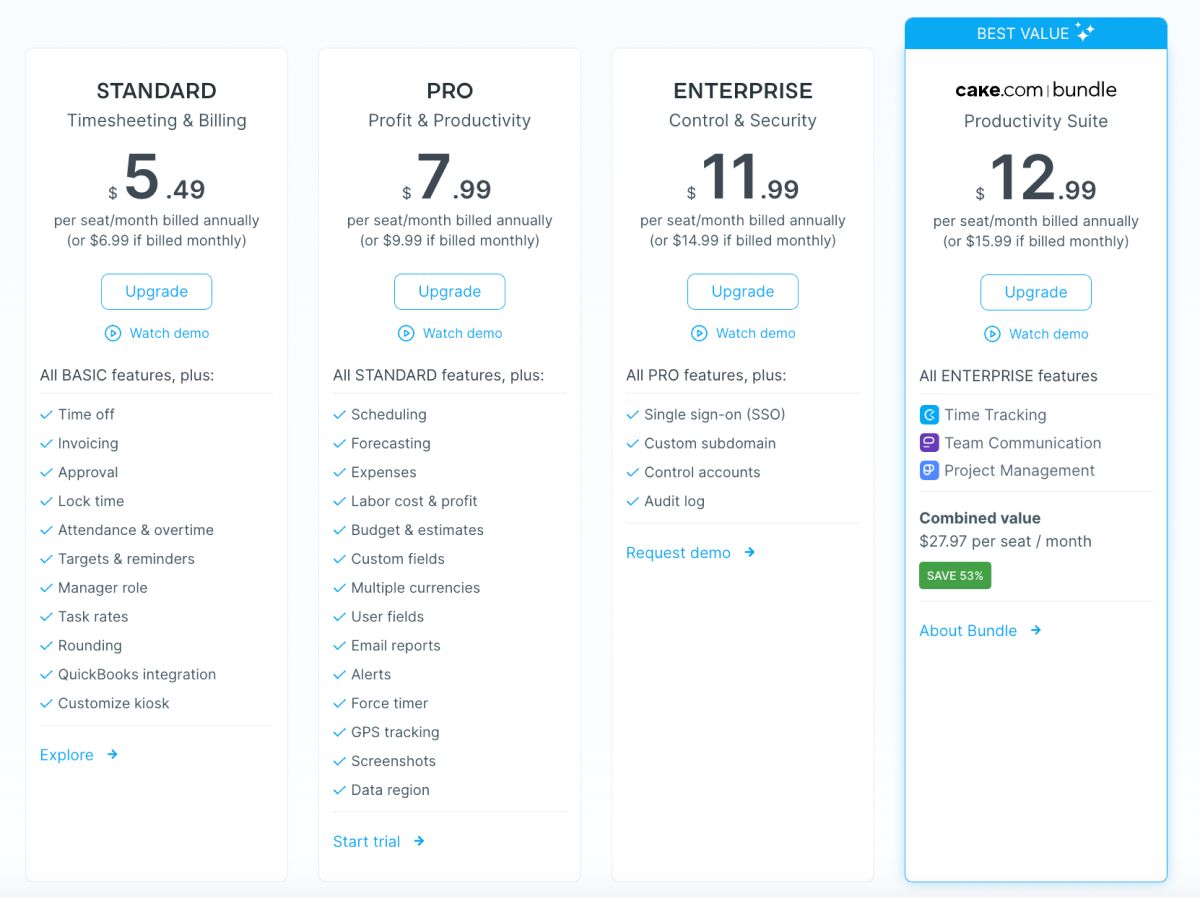You probably already know that organizing your day and managing your time is vital for success at work.
But, you may not be sure exactly how to achieve that, especially if your job requires you to jump around from task to task.
Still, it’s not all doom and gloom, especially since we’re about to let you in on some tips and tricks on improving your time management skills the right way.
From setting SMART goals to achieving maximum results with minimum effort, we’re about to give you a helping hand in becoming a time management master.
So, let’s dive in, shall we?
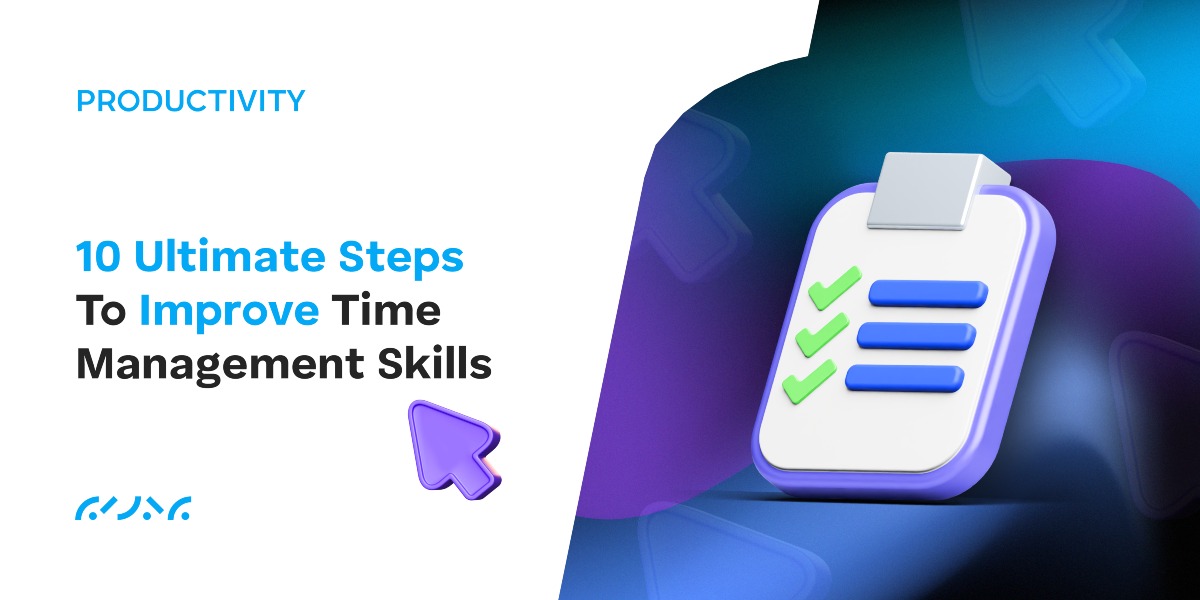
Table of Contents
What are time management skills really?
Time management skills are the skills that help you achieve more in less time — and they’re more varied than you’d think.
That being said, each time management skill can fit into one of the following categories, depending on its main goal:
- Primary time management skills, such as scheduling, planning, organizing, and prioritizing. They directly help you perform your work efficiently.
- Secondary time management skills, such as eating healthy, exercising, and sleeping enough. They keep your mind sharp and energy levels high to help you perform better with your primary time management skills.
At face value, it may seem clear why all these skills are noteworthy. But other times, you may forget about the impact proper time management can have on your overall well-being. So, let’s quickly untangle the basics to help you on your road to mastering productivity.
Manage your time with Clockify
Why are time management skills important?
Time management skills matter because they are a direct reflection of your habits and the type of your personality. These skills improve the quality of your life in many ways, both in regard to your professional and personal life.
Therefore, some of the goals of mastering the right time management skills are:
- Achieving a near-perfect work-life balance,
- Reducing your stress levels,
- Improving the state of mental health, and
- Accomplishing academic and career-related achievements.
Proper organization of your priorities implies an organic development of healthy habits and further results in your happiness.
Since being in charge of your schedule and the order of your activities brings structure to your life, it’s only logical that improving your time management skills would bring you joy.
💡 Clockify Pro Tip
Want to learn more about the importance of time management? Check out our blog post:
Why time management may be difficult for you
Are you having trouble sticking to your to-do list? Do you feel like you just could’ve done more at the end of the day? Have you tried every single app under the sun, and none of them lasted longer than a week on your phone before you gave up?
The good news is — there’s nothing wrong with you. The bad news is — it might take a while until you get better at this. And I’m about to tell you why.
You lack three key qualities to work
Mastering your management skills requires a shift in understanding time. To achieve this, organizational psychology expert Erich C. Dierdorff advises working on three skills:
- Awareness of time — realizing it’s limited, keeping a realistic outlook on time.
- Arrangement — handling your schedule, planning, and prioritizing to make the best use of time.
- Adaptation — observing and analyzing your use of time for further improvement and learning how to adjust to the changes in your schedule.
To determine whether we all know each of these three skills, Dierdorff decided to give 1,200 participants a 30-minute test.
In a nutshell, he noticed that arranging came much easier to them than awareness and adaptation. This means people scored better at organizing their schedules. Yet, managing shifts, cancellations, overextensions, and any deadline disruption was handled worse.
From this, Dierdorff concluded that awareness and adaptation are much more difficult to master. In fact, it could explain why we always struggle with procrastination and maintaining healthy habits — even when our plans seem foolproof.
Just like his participants, you too might be better in only one or two-thirds of those skills.
Let’s see how you can practice these skills until you reach a healthy balance between them.
💡 Clockify Pro Tip
Eager to learn why you feel like time is causing you anxiety? Well, check out our article:
How to improve your time management skills
To learn how to improve time management skills, you’ll first need to track the time you spend on tasks — to get an accurate reading on how you’re spending time now.
Perhaps you’ll find that you’re spending too much time on frivolous activities (such as two hours answering unimportant emails) instead of focusing on important and urgent tasks.
You’ll also need to learn, acquire, and expand on certain time management skills. And what better way to learn about this topic than by presenting time management skills examples?
So, here are ten steps to help you manage time in a better way.
Step #1: Create clear goals
Setting effective goals may be the most important time management skill! Goals are your drive, so much so that they push you to tackle work in the first place.
Make sure to always set important goals, ones that are likely to motivate you, either intrinsically or extrinsically. That is to say, either by focusing on your inner values or external stimuli, like rewards.
Otherwise, you’ll lose your drive and likely give up as soon as you hit a bump on the road. You probably won’t finish your work, and you’ll also waste valuable time you’ve spent pursuing the said goal.
Track your goals with Clockify
Substep #1: Practice awareness by playing video games
Dierdorff’s research had the participants perform in a microsimulation that lasted half an hour. In much the same way, you can test your time management, organization, and prioritization without any fancy tools, at home.
But what could you use instead?
Video games!
Plenty of video games rely on time and resource management, with as much or as little story and frills as you want. These games provide microsimulations of their own, where you need to juggle:
- Resources,
- Time,
- Tasks,
- Employees, and
- Random events.
The goals are usually to either earn enough money to keep your shop/restaurant/business afloat or to get the best possible results for each day and become successful.
In fact, time management games are the simplest yet most fun way to get a glimpse of how you manage time and what aspects of work you prioritize.
Just make sure to actually pay attention to your play style. Otherwise, you’ll just be playing video games instead of treating them as a learning opportunity.
Substep #2: Spend some time introspecting
One thing that I did and found the most beneficial was to create a visual representation of my time awareness. That way, I was able to identify everything that was wrong with my perceptions and that blocked me from becoming more productive.
Here’s how I did it:
- I identified the biggest problem first
The eyesore was my procrastination — I wanted to get the work done but couldn’t physically bring myself to it.
- I wrote down my behavior patterns
Usually, my behavior patterns involved looking for the appropriate music to help me focus (and then getting distracted). I also noticed that as soon as I began working, I’d also immediately remember I needed to call a friend for something important, a specific chore, and so on.
- I noted the feelings that came with the behavior
As is the case with procrastination, I felt guilty, incompetent, and afraid that I would need to postpone my tasks. Even though I was aware of my feelings, I still jotted them down next to each behavior. That way, I saw what caused me the most distress. As a result, I figured out a solution.
- I kept asking “why”
Along with the feelings, I also tried to answer the question “why.” For example, Why did I choose to waste time picking out music? Why did I feel the need to call that friend now? Why couldn’t I do the chore in half an hour, after I’m done with the task?
- I analyzed the grid
This activity works similarly to journaling. You put the struggles onto paper and explore them in detail. In turn, this visualization of your struggles gives you a different perspective on the issue.
Now that you know how to look inwardly, let’s head to the centerpiece!
Substep #3: Set goals
To set effective goals, you’ll first need to make sure they’re SMART goals. In other words, they need to be specific, measurable, attainable, relevant, and time-bound:
- Specific goals are clear and precisely defined, so you know what you need to do to reach them.
- Measurable goals let you measure your success and decide whether you’ve reached it.
- Attainable goals are possible to reach, so they motivate you to push forward, but they’re also at least a little challenging to motivate you to do your best.
- Relevant goals have an impact on your life and career, so they actually make a difference when you achieve them.
- Time-bound goals have a deadline that tells you how to organize your work, and they give you a sense of urgency that helps you focus on your work.
In addition to setting SMART goals, you can also make a goal-setting worksheet to always have your goals in mind:
- Write down what you want to achieve. Phrase it with “I will achieve this” and not “I would like to achieve this,” as such phrasing will give you a sense of urgency and certainty that you’ll be successful.
- Plan the actions that will lead you to your goals. In other words, compile a weekly to-do list, define your priority tasks, and write down your objectives.
- Identify why you want to achieve certain goals and how. Write down your goals, your plan for that goal and why you are pursuing them in the first place.
💡 Clockify Pro Tip
Interested in goal setting for students? Check out our all-inclusive article on student productivity:
Substep #4: Rely on persistence, not motivation
One of the best and most commonly overlooked pieces of advice is to not rely on motivation to work — but on pure persistence.
It’s not surprising why we often push away the notion of stubbornly starting a task even if we don’t feel like it. It’s unpleasant, we would rather do anything else, and we have no clue if the output is going to be worth the effort. As a bonus, we’ll feel awful the whole time, right?
Well, as awkward as it can be, sometimes we need to parent ourselves and enforce discipline. On one hand, it can become a stable drive after some time.
On the other hand, as artist and productivity coach Katy Arrington shared with me, sometimes you just need the right goal to manage your procrastination. Instead of beating yourself up over a lack of discipline, it’s better to find real, tangible goals that will pull you out of the rut when you most need it.
Step #2: Plan ahead
Once you’ve set your goals, the next time management skill you’ll need to work on is effective planning. In fact, you’ll need to learn how to make an action plan that leads you directly to your goals and helps you avoid stress and wasted time.
Planning ahead will help you establish a routine and get things done time and again.
Substep #1: Reinvent your to-do list
Let’s start with your everyday companion — the to-do list. In an article for Harvard Business Review, Peter Bregman of Bregman Partners said how:
“For many of us, our to-do list has become more of a guilt list: an inventory of everything we want to do, plan to do, really should do, but never get to. It’s more like an I’m-never-going-to-get-to-it list.”
And he makes a very good point. A lot of the time, we write a list of tasks that need to be done without taking into account how much time or energy they will take. And by the end of our workday, we’re stuck regretting not having done everything we put on our platter.
In the same HBR article, Bregman proposes that instead of a vague to-do list, we adopt fewer bulleted points but with stricter work times.
This is best achieved with the timeboxing method. With this technique, you determine a fixed amount of time for each task, with one caveat — you begin and end the task at the exact minute you set.
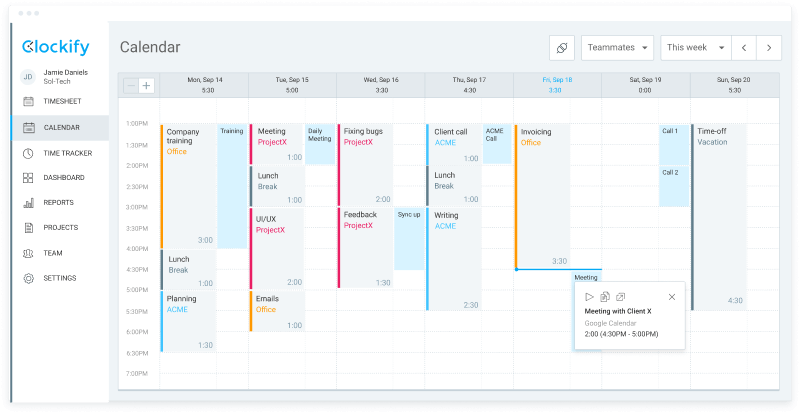
When your work times are flexible, you risk slipping into a 12-hour workday. A strict framework, such as timeboxing, will help you accomplish more throughout the day and finish on time.
Substep #2: Analyze your situation
When planning, it’s easy to get sidetracked due to several barriers to effective planning:
- You don’t know what you want. When you don’t know your destination, there’s no possible way you’ll know how to get there. Work on defining your goals first, and the steps you need to add to your plan will become clearer.
- You haven’t analyzed the situation properly. If you don’t know where you stand at the moment in relation to your goal, you’ll hardly know what you need to do to proceed. Analyze your situation first, and then decide what steps will lead you to your goals.
- You have to deal with too many distractions. You try to do too many things at once, and you perform subpar on most of them. Give yourself space to focus on your priorities, and discard anything that isn’t important or urgent.
- You don’t engage in creative thinking. Each problem has a solution, and each impossible schedule has a creative interpretation. Think about the best and fastest ways to reach your goals, and write them down.
Apart from the listed barriers you need to overcome, there are several guidelines for effective decision-making, as well as five steps in the planning process you can follow:
- Develop objectives! These are your ultimate goals.
- Define the tasks that will help you meet those objectives! These are the steps you need to include in your plan to reach said goal.
- Determine the resources you need in order to reach your objectives! These are the skills, knowledge, and expertise you need to successfully handle these steps.
- Create a timeline! This is your way of deciding when you’ll tackle certain steps in your plan.
- Determine a tracking method! This is what determines whether you’ve reached your goal.
Step #3: Learn to manage your stress
According to the American Psychological Association, about 77% of people in the US experience physical symptoms caused by stress. Secondly, around 73% face psychological symptoms.
When you’re physically and psychologically unwell, you’re probably lucky if you manage to keep up, let alone do more in less time.
Manage your time with Clockify
So, stress management in the workplace is one of those secondary time management skills that help you perform better at your primary time management skills — and, thus — at work.
Benefits of stress management include the reduction of many risks, such as the chance of having to deal with:
- Sleep problems,
- Physical problems, like heart disease, high blood pressure, stomach aches,
- Frequent migraines and headaches, and
- Mental health problems, such as anxiety and depression.
Once you decrease the chance of these issues through stress management, you’ll clear the path to better productivity and understand how to manage time better.
💡 Clockify Pro Tip
What’s the difference between stress and mental fatigue? Learn that and more in our post:
Substep #1: Find innovative ways to deal with stress
To learn how to manage stress at work, you’ll need to learn how to deal with and relieve stress and anxiety as a whole.
Luckily, there are plenty of fun stress-relieving activities you can try from time to time:
- Laughing, even if it’s a forced laugh. A study by psychobiologist Matthew Gervais and evolutionary biologist David Sloan Wilson shows that laughter reduces the levels of stress hormones in your body, such as epinephrine and cortisol.
- Eating some dark chocolate. A group of researchers suggests that this healthy sweet is a superfood that reduces the level of oxidative stress. The latter means a disturbance in how your body distributes and handles oxygen.
- Listening to music. Your favorite music can help you feel less stressed but also help you increase productivity in the long run. In fact, the latest productivity statistics show that 71% of people feel more productive when they listen to music while working.
- Dancing to music. One study by the National Center for Biotechnology Information shows that dancing reduces anxiety even more than classic exercise. Similarly, it also increases endorphins — brain chemicals that increase your pain tolerance, satisfaction, and euphoria.
Once you’ve lowered your stress levels, you’ll be more likely to carry out your work faster — and in a quality way.
Substep #2: Learn accountability
High-performing employees thrive on deadlines and accountability. When you hold yourself accountable, you create a sense of ownership. In turn, the sense of ownership makes you want to create more outstanding work. Before you know it, you’ve created a repetitive loop that feeds itself!
But aren’t all those deadlines and responsibilities stressful?
Counterintuitively, you can learn to manage stress by becoming more accountable — not less. But how do I do that, you might ask.
First, you need to know what your workload looks like.
Second, you must understand your duty associated with that workload.
When you complete these two simple steps, you’ll have a clearer picture of what you expect from yourself and what others expect of you.
For example, suppose you have two tasks to complete today and clear deadlines for both. In this case, it’s easy to be more accountable since you’re not wondering what and when you should do next. Remember that accountability breeds action and vice versa.
In a nutshell, being accountable means that you:
- Offer solutions instead of complaints,
- Be open to criticism and fix your mistakes, and
- Develop a proactive approach.
All this seeps into the rest of your life, helping you show up for your friends, family, and others in your environment. In other words, being accountable in all spheres of your life.
When you are working, then by all means, work away and get things done. But when you’re spending time with your loved ones, then try to ignore your job for that time.
Substep #3: Rest and recharge
Your work-life balance should be about more than just work. In fact, a recent Gallup poll suggests that three in ten US employees feel burned out at work “very often” or “always.”
Unsurprisingly, this leads people to leave their jobs — and results in negative effects and stress. But what do you do about it?
Like with most other things in life, there’s an antidote to fix it. It’s called rest and recharge! As a quick test, ask yourself:
- What do you want to get out of your job?
Is it the always-on mode, with constantly being available to your coworkers, even while you’re on vacation? If so, I can’t argue with that. But most likely, you want something else. So it’s probably a mixture of a reasonable amount of work and then a fair portion of rest.
Imagine two persons:
- The first person feels passionate about their work and wants to get more of it without resting properly.
- The second person despises their work but still has to pay their bills by working hard.
Both behaviors lead to similar results: discontent and burnout.
To fight them, take a week off every few months. Time off helps you preserve your mental clarity and vigor — and prepares you to do outstanding work after you get back to work.
💡 Clockify Pro Tip
Want to learn about the difference between paid time off and vacation? Check out our blog below:
Substep #4: Recognize you’ll have bad days
Quite often, I run into YouTube videos and articles about allowing yourself to experience bad days — when time management simply isn’t going your way. And while that’s true, I’ve often felt guilty if two or three such days line up. What’s more, these resources seem a little scripted, in a way, and I can’t really relate to the author.
That was until I ran into a video by Matt D’Avella, whose productivity YouTube channel counts millions of viewers. His videos focus on productivity, self-improvement, and avoiding burnout/hustle culture.
For a video titled How I stay productive all day, surprisingly, he wasn’t as efficient as you’d expect! Seeing the montage of him going through the day struggling with some tasks, failing in some places, and succeeding in others, to ultimately end it putting off some bigger tasks was — refreshing.
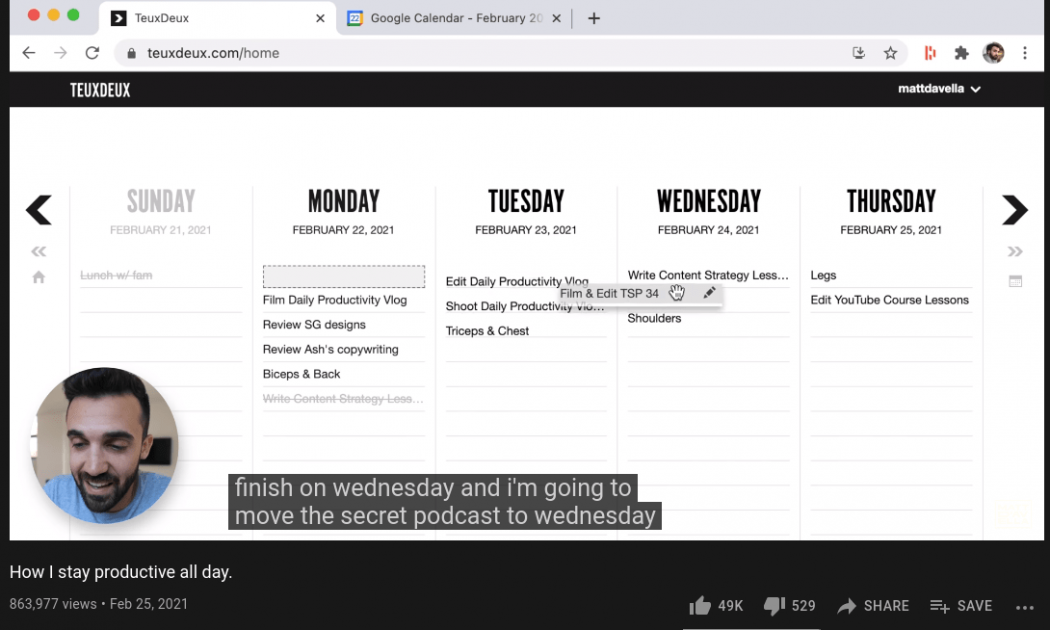
I felt oddly comforted when I saw D’Avella face the unpleasantness of not finishing some important tasks, only to make peace with it, shrug it off, and hit the gym at the end of the day. It showed me that we need an equal amount of understanding, letting go, and trust that we can finish those tasks next time. In other words — adaptability is key!
The more you fret over your schedule, the time you wasted, or what didn’t work, the more rigid you become.
Schedule tasks easily with Clockify
Substep #5: Practice self-care
Plenty of research suggests that some contemplative practice, like mindfulness meditation, helps you become more centered and worry less. As a side effect, you don’t need to fret about losing your edge at work. In other words — becoming calmer doesn’t diminish your job outcomes.
But let’s not just talk about research, as it can feel impersonal. I, for one, meditate every day for around 30 to 50 minutes. I don’t do it in one chunk but spread it out evenly throughout the day. After three years, I feel astounding benefits.
For example, I’m better equipped to:
- Notice rage before it erupts into me saying bad stuff,
- Recognize external stimuli without giving in, and
- Feel joyful and non-reactive on most days.
If that isn’t enough, I don’t know what is. To top it off, you don’t need to meditate for years to reap the benefits. A few days will do!
The second self-care practice is even more critical. Yep, I’m talking about sleep! You know, that thing many modern-day employees try to avoid thinking their time is better spent working.
Well, sleep scientist Matthew Walker begs to differ. In his book, Why We Sleep, he brings home the point of why sleep is an unavoidable ingredient:
“Over a fourteen-year period, those sleeping six hours or less were 400 to 500 percent more likely to suffer one or more cardiac arrests than those sleeping more than six hours.”
Walker goes on to explain that sleep is the most effective thing we can do to reset our body and brain health every day. And who am I to disagree with him?
Finally, try to sleep at least seven hours and introduce some kind of mindfulness meditation. To help you with that, try Sam Harris’ Waking Up app!
Step #4: Delegate and outsource tasks
As the business magnate Andrew Carnegie once said:
“The secret to success lies not in doing your own work, but in recognizing the right person to do it.”
Several reasons show the advantages of delegation and outsourcing in relation to your time management efforts:
- You cannot accomplish everything on your own.
- Perhaps someone knows a better way to solve a problem you’ve been struggling with.
- Sharing responsibilities increases trust among colleagues.
- Delegation and outsourcing will help you grow as a leader and assertive professional.
So, the importance of delegation in management is simple. Once you share the load and delegate less important and urgent tasks to other people, you’ll have more time to focus on tasks that are urgent and important for your goals.
For this reason, to avoid feeling bad or guilty about delegating tasks, you ought to practice saying “No” politely yet effectively.
Substep #1: Follow the principles of delegation
To learn how to effectively delegate work to employees, colleagues, or even friends and family, you’ll need to follow certain principles of delegation.
In gist, the time management technique that focuses on delegating tasks in this manner is called Who’s got the monkey. It follows the short rules below, where “monkeys” represent delegated tasks.

So, you’ll need to do the following steps in order to up your delegation game:
- Decide what you’re delegating,
- Choose the right person to delegate the task to,
- Make sure the delegatee knows the expected results, and
- Regularly check on task progress.
Now, let’s look at each point in more detail!
Substep #2: Decide what you’re delegating
First, write down your tasks on a to-do list.
You’ll probably notice that some of the tasks you’ve listed are urgent but not all that important in relation to your goals.
These are the tasks that need tackling as soon as possible. But since they’re not of crucial importance, you don’t need to be the one to do them. Therefore, delegate, delegate, delegate!
Substep #3: Choose the right person to delegate the task to
Decide what skills are needed to finish the task in the best possible way. Then, delegate the task to the person who has the strongest relevant skills.
If possible, always delegate front-end development to front-end developers, user interface design to UI designers. You get the point.
Delegating tasks to the right people doesn’t just apply to hard skills.
Suppose you need someone to deliver a company presentation at an industry event but don’t have an official spokesperson. In this case, try picking someone communicative, creative, and resourceful.
Only when you pick the right person to handle a task can you count on optimal results.
Substep #4: Make sure the delegatee knows the expected results
If you want to achieve the best possible results with a delegated task, you’ll need to explain to the delegatee exactly what you want to achieve.
In other words, provide clear instructions, recommend the best way to handle the task, or give advice on the matter.
Unless you do, you may not be completely satisfied with the result.
Substep #5: Regularly check on task progress
The question of how to monitor delegated tasks is the last you need to answer. Best practice suggests providing occasional follow-ups on the task to make sure everything is going as planned.
In any case, ensure you don’t succumb to micromanagement. After all, you’ve delegated the task. Now, you should let the delegatee be accountable for and in charge of task execution.
Step #5: Focus by limiting your distractions
Avoiding distractions and focusing at work are often defined as two separate time management skills. But, if you avoid distractions, this automatically means you’re focusing on a task at hand.
In a traditional working environment, distractions are many — the most common one being chatty colleagues in your office. Even your mobile phone can be a distraction, sitting on your work desk, tempting you to go through your Instagram feed every two minutes. The list is endless!
To help you with those pesky distractions, I have a few tricks up my sleeve!
Substep #1: Fend off unending interruptions
As the adoption rates of remote work skyrocketed, many people struggled to focus while working from home.
That brought a whole new set of challenges and expanded the list of distractions. From your household members, various chores, loud music coming from the apartment next to yours, to the sound of your neighbor mowing the lawn.
We get it, the change was abrupt, and it’s all making it more difficult to focus. This goes especially for freelancers, given the fact that they are not supervised in a conventional manner. For the vast majority of them, their home is their permanent working environment.
However, there are some steps you can take to deal with such distractions. In fact, we’ll provide several examples below to help you brainstorm and get your creative juices flowing:
- Set clear boundaries with the household members and neighbors — ask them for cooperation.
- Cultivate a productive workspace and build your own home office (preferably behind a closed door).
- Avoid working in your bedroom or common space.
In gist, distractions may be various, but they all have one thing in common — they hinder your work performance and slow you down on tasks.
💡 Clockify Pro Tip
To get a better sense of how other employees handle their daily challenges, check out this article packed with bits of knowledge from experienced remote workers:
Substep #2: Reduce unnecessary meetings
Meetings are turning into a nightmare for the workforce at large. So much so that statistics imply a worrying trend among senior managers and other professionals alike.
For one, Covid has exacerbated the prevalence of unproductive meetings. But remote workers now say things look bleak even as the pandemic begins to decline.
Many voice their concerns that most meetings don’t help them do their jobs better. Along similar lines, others assert that the one-hour meeting could have been a short message or an email. To confirm this doubt is one piece of research by Microsoft, which suggests that 43% of their remote workers say they “don’t feel included in meetings.”
In contrast, here are a few things you can do to stay focused by avoiding do-nothing meetings:
- Ask your client or coworker to trim meetings by 30%,
- Introduce no-meeting days, and
- Request the inviter of the meeting to provide a detailed agenda.
All these things can help you have better and fewer meetings, and who doesn’t want that?
Step #6: Avoid multitasking at all costs
The multitasking myth is prevalent and suggests an attractive prospect. In short, the myth suggests that you can perform more tasks in the time it would usually take you to perform one task. Yet, science makes its case clear on multitasking — simply don’t do it.
According to multitasking research, there are plenty of negative effects of multitasking that show this practice doesn’t work the way you’d expect. In contrast, multitasking:
- Lowers your IQ. A study at the University of London claims that multitasking may make your IQ drop by 15 points, reducing you to the cognitive capacities of an eight-year-old child.
- Damages your brain. A study at the University of Sussex shows that multitasking may diminish your brain density and may damage your brain.
- Makes you lose time. With single-tasking, you gain momentum as time goes on and immerse yourself in the task, ultimately reaching a state of deep work, the most pleasing of all work modes.
Since the answer to the question “Can your brain multitask?” is a firm “No,” your only option is to practice effective single-tasking.
Substep #1: Use the Pomodoro method
One of the most prized possessions in the modern-day worker’s toolkit, the Pomodoro technique does wonders for everyone who decides to use it. Pomodoro is a time-tested approach to productivity that has been around for a long time — and for a good reason!
In a nutshell, it’s made up of three simple steps:
- Choose one task that’s important to you,
- Set a timer for 25 minutes, and
- Work on the task until the timer rings.
That’s it. That’s all the magic!
Also, if you want to boost your focus during this period, install a distraction blocker like Cold Turkey. It will help you fend off distractions in your deep work mode.
When the 25 minutes expire, you can take five or ten to recharge. Finally, set another timer. Rinse and repeat!
Personally speaking, I use the Pomodoro technique in beast mode. That’s to say that I work in 60-minute sessions and then take longer breaks. It’s what makes sense to me. Likewise, see what’s practical for you.
In any case, take advantage of this ancient technique that has helped millions of employees produce their best work!
💡 Clockify Pro Tip
If the Pomodoro technique isn’t your cup of tea, we got you covered! Check out this blog:
Substep #2: Focus on one task at hand
Since single-tasking is the new multitasking, here’s how you can best achieve it:
- Get rid of distractions. Put your headphones on to block outside noise and chatty colleagues. Set your phone to silent or simply leave it in another room where you won’t be able to reach it every five minutes. Set your devices to the “Do Not Disturb” mode. There’s Focus Assist for Windows, and a Do Not Disturb toggle switch on Apple devices.
- Designate distraction-free focus time. It’s much easier to stay focused on one task when you know how long you have to remain focused. Therefore, try to time block your schedule. In fact, science shows you should block 90 minutes for a task in one sitting at the most.
- Take regular breaks and parse your tasks into meaningful wholes. Single-tasking doesn’t have to be a boring and monotonous race to finish one giant task in one sitting. No matter how long it takes! You can parse your task into smaller sub-tasks, and you should always leave time in your schedule for breaks. As long as you take enough breaks to help you recharge and work on one sub-task until you’re finished with it, you’ll still be single-tasking.
Step #7: Use time management tools to establish routines
In all truth, there are always new and better ways to improve time management.
For example, working smarter, not harder in the Information age means leveraging the power of the available time management tools.
So, can time management apps and other tools help you understand how to develop time management skills?
The answer is — yes, by pointing out the techniques that will work for you.
First of all, tools such as time tracking software and time management calculators serve one general purpose. In other words, they help you understand your current distribution of time as it relates to your activities.
Improvement and progress can start only after you get that insight.
Now, you may be wondering why that would be true. If that’s the case, we figure you’ve never tried using time management tools. At least not regularly or long enough to develop a habit.
So, how can you use these tools, and why are they beneficial?
Substep #1: Get a better grasp of your time
For starters, time management tools boost your performance simply by raising awareness of how you allocate a very limited resource of time.
Therefore, they allow you to pinpoint the time wasters. Perhaps you’ll find room for improvement in terms of a better sequence of tasks, for example, by batching similar tasks together to save time.
So, the next level is when you start using the tools to plan more efficiently and create a schedule. In fact, time management becomes easy when you are able to plan ahead, with a little help from tools.
Substep #2: Schedule tasks in advance
The way we concentrate and manage our focus relates to one of the four time management categories:
- Time tracking,
- Productivity boosters,
- Project and task management (in relation to time), and
- Habit-tracking.
Here’s an actual example of usage — time management calculators. They would fit into the last category we’ve listed. Time management calculators are a great solution to help you create time frames for your regular activities. In fact, they make time management improvement seem like a walk in the park!
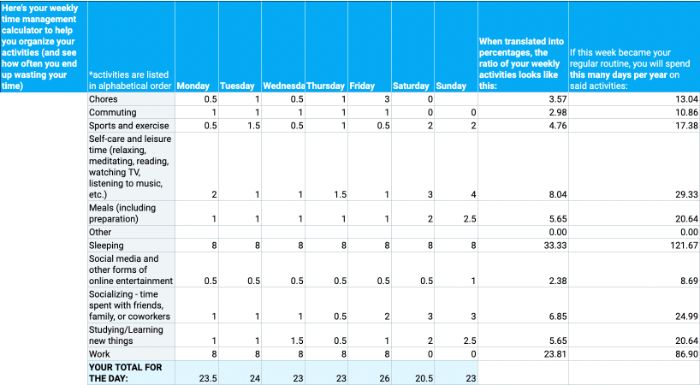
For illustration, the usage of these calculators can be proactive and retroactive.
Retroactive calculators require that you make a time entry of each activity from the past so that you have a clear understanding of how you alot time. In contrast, proactive calculators help you make time estimates for the future based on the results from your retroactive calculations.
After a couple of weeks of using proactive and retroactive calculators, you can practice scheduling your activities and tasks in advance.
💡 Clockify Pro Tip
Need to take your time management calculations further? Get free examples here:
Step #8: Follow the Pareto principle
According to Italian economist Vilfredo Pareto and his Pareto principle, 80% of all problems result from 20% of all the causes.
More precisely, the definition states that investing 20% of your efforts in the right place will help you achieve as much as 80% of your desired results.
In essence, you do less but achieve more, which saves you time.
As a result, you notice a boost to your confidence — you’re not trying too hard, but you’re still successful.
The use of the Pareto principle in organizational skills and time management is simple. For example, you can work on select tasks first to do less but achieve a greater, more noticeable effect.
If we take the above examples into account and make them more concrete, here’s how the Pareto principle works:
- 80% of problems in your program come from 20% of all the currently reported bugs. If you have ten bugs and solve the right two, you’ll increase your program’s performance by 80%.
- 80% of all your sales come from 20% of your products. It’s best that you don’t expand your manufacture to 20 different products. Instead, focus on perfecting the four that sell the best.
- 80% of all your customers only use 20% of your app’s features. Similar to the example above, you should focus first on streamlining your most popular features and then consider expanding your functionalities.
💡 Clockify Pro Tip
Want to geek out about the Pareto principle? Conveniently, we prepared an article on this topic:
Step #9: Prioritize wisely
When you have several tasks to do but don’t know where to start, there’s only one thing you can do to make your time pay off the most: Single out your priorities and make plans.
Planning and prioritizing involve deciding whether a task is important and whether it’s urgent. Naturally, you’ll tackle important and urgent tasks first, working your way down from there.
Substep #1: Focus on your priority tasks
On top of the productivity mammoth sits the Eisenhower Matrix. It’s a prioritization technique that operates on the following principle.
First, you divide your tasks into four quadrants:
- First quadrant — important and urgent tasks. These tasks are your top priority and should be handled immediately.
- Second quadrant — important but not urgent tasks. These tasks are important enough to be tackled next but not urgent enough to make them your top priority.
- Third quadrant — urgent but not important tasks. They should be handled immediately, but as they’re not important, you should delegate them to colleagues.
- Fourth quadrant — neither important nor urgent tasks. You should eliminate them from your to-do list.

Substep #2: Chunk your tasks
If you’re like most people, you’ll want to beat your to-do list into submission. Yet, that rarely happens as you would expect. Instead, things get in the way, including meetings, unplanned requests, family appointments — you name it.
But one sin we’re all guilty of is putting too ambitious tasks on our to-do lists. These are things like:
- Write a 3,000-word magazine article,
- Get funding for my business,
- Become an entrepreneur, and
- Double my earnings by the end of the month.
What all these items have in common is that they are indigestible tasks. In other words, it’s unclear what steps you need to take to perform them. More worryingly, people sometimes mistake tasks for goals.
In contrast, try chunking your big tasks or goals into smaller, easily digestible items. Instead of writing “become an entrepreneur,” you can jot down:
- Enroll in ten entrepreneurship trainings,
- Find mentors to guide me,
- Uncover my profitable product,
- Write a business plan,
- Secure funding from such and such, and
- Launch my business.
This is not an exhaustive list, but it will help you to transform your mindset.
Finally, chunk your tasks into smaller sub-units that you can tackle immediately. That way, your to-do list won’t look like an unattainable ideal but an easy next step.
💡 Clockify Pro Tip
Do you need foolproof plans? Read our in-depth guide on why your life thrives under better planning:
Step #10: Quit procrastinating
Procrastination almost always involves delaying or postponing something. It can be anything from putting off work on your new project or a visit to your grandmother.
By postponing something, you’re essentially losing time through this delay. So, it’s important not to ignore your procrastination habits. Unless you do something about them, you may even increase your risk of suffering from chronic procrastination. Did I already say you don’t want this in your life?
Moving forward, there are several answers to the question of why we procrastinate. For example, you might:
- Think you have enough time. Your deadline is two long months away, so you binge-watch Netflix shows or go out every night until you realize that time really does fly. And then, suddenly, you have one week to write, proofread, and edit a 20,000-word essay.
- Tend to avoid unpleasant tasks. You don’t want to think about difficult tasks or challenging problems, let alone try to tackle them. So you rearrange your desktop files and folders by color and alphabetical order instead.
- Feel overwhelmed with work. You have so much to do in so little time that you feel unable to start in the first place. So, you procrastinate.
- Be afraid of failing. If you don’t do something, you can’t fail at it. Seems reassuring, but most things worth the effort require you to try.
- Worry about the unknown. If you don’t venture into the unknown, you’ll never be unpleasantly surprised.
💡 Clockify Pro Tip
Ever heard of Parkinson’s law? If you haven’t — or have but want to learn more — read our blog post:
Substep #1: Change your time-attitude with a mantra
When looking for successful entrepreneurs’ perceptions of time in my research, I ran into one by Rosie Guagliardo of InnerBrilliance Coaching. She said that you can still feel stressed, even if you align your activities with your priorities:
“Since you can’t change the time you have, change how you feel about it. If you’re thinking you don’t have enough time, it’ll feel stressful. Tell yourself ‘I have all the time in the world.’ You’ll feel calmer, more present and open to new and different solutions, allowing you to get more done.”
It goes right to the core of changing your awareness of what time is and how you should feel about it. There are thousands of sayings about time, and one of them will probably resonate with you. It’s such a small action but a significant one. In fact, your choice of the quote will say a lot about your biggest insecurities, concerns, or hopes about time.
Keeping it in mind or repeating it every day is bound to burn the mantra into your consciousness.

Substep #2: Pace your workload
Overcoming procrastination seems daunting. Still, there are several tactics you can try to help you focus and stick to your work to:
- Avoid thinking you have enough time but make your distant deadline seem more immediate. Likewise, parse the said task to smaller sub-tasks with closer deadlines, and work accordingly.
- Encourage yourself to tackle unpleasant tasks. In other words, set a short period during which you’ll focus on these tasks and simply power through.
- Prevent yourself from feeling overwhelmed by parsing your workload to more days and periods in the day. Depending on your situation, it might mean working in the evenings to spread out your work hours evenly throughout the day.
- Beat the fear of failing. Do this by redefining your goals and lowering your expectations. Instead of setting “succeed at any cost” as your goal, set “learn something new” as your new goal.
- Lessen the fear of the unknown. For example, you can visualize your obstacles and make a list of possible problems you may encounter. Doing so will make your work process less unknown — and thus less daunting.
💡 Clockify Pro Tip
Want to learn more about procrastination, including more reasons why we procrastinate and how to fix it? Check out our all-inclusive post on the subject, complete with a list of famous procrastinators and how they deal with procrastination:
Manage your time better and boost your productivity with Clockify
Although improving time management skills requires constant effort, there are some tools that you can use to ease the process of perfecting time management.
One of these tools is Clockify — time tracking software that offers more than enough options to help you better manage your time and increase your productivity.
For example, if you want to schedule your tasks and work more efficiently using timeboxing, Clockify can help you do it.
Once you decide on the tasks you want to tackle, you can determine a fixed amount of time for each task in Clockify. To make sure you stay within the given time frame, start Clockify’s timer and begin working on the first task.

When you’re done with the task, simply stop the timer. Then, you’ll be able to see the tracked time for all your tasks and analyze it in Clockify’s Calendar.
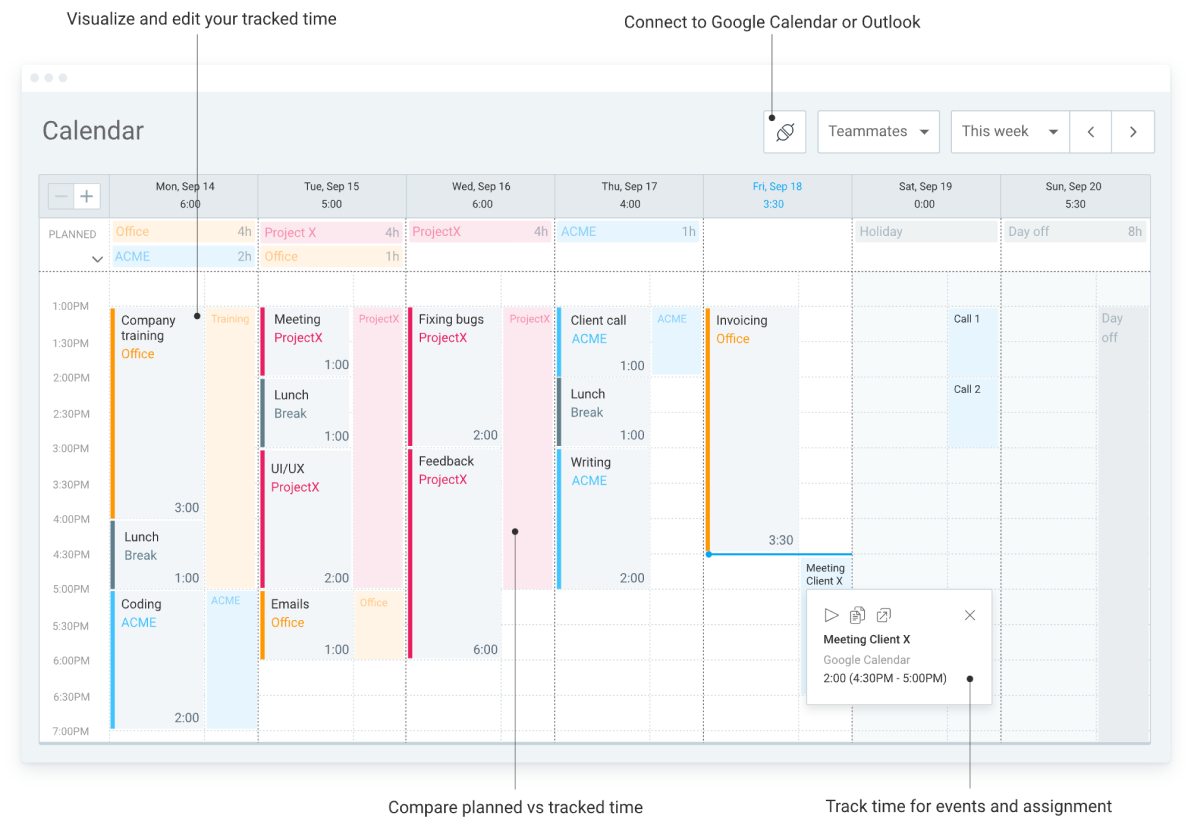
That way, you’ll be able to see if you’ve managed to stay within the set time frame, as well as if you’ve achieved your goals. By assessing your results, you’ll actively work on your time management and increase your productivity in the process.
Aside from its time tracking capabilities, Clockify comes with many different plans that offer additional features to increase your productivity, such as time reporting and targets — so give it a try.
